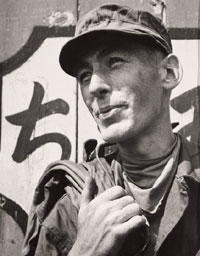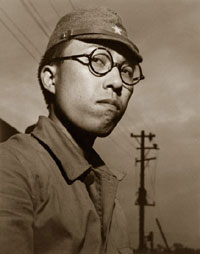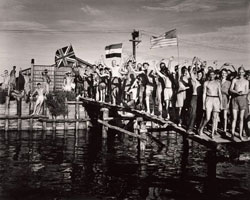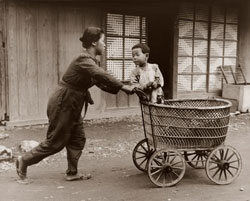John Swope: A Letter from Japan
The World War II Series > Vanuatu > Betio Guns > John Swope > Kiribati
For the Captain nothing beats a little history lesson. The exception of course is those frequent visits from his debt collector.
 This week he is flipping through World War II photos of Japan just prior to its surrender. Take a seat, folks, class is in session.
This week he is flipping through World War II photos of Japan just prior to its surrender. Take a seat, folks, class is in session.
John Swope (1908-79) probably had quite a story to tell Jimmy Stewart and his other celebrity buddies after returning from Japan, where he photographed the devastation at the hands of the Allied forces near the conclusion of World War II.
The Hollywood photographer's assignment from the US Navy was to photograph the Allied prisoners of war as they were being released just prior to Japan's surrender.
With his Rolleiflex 75mm, Swope walked through rubble and burned-out structures and befriended Japanese both young and old alike during his three-week tour at the end of August 1945.
The resulting collection of portraits and a letter written to his wife, both now on display at the UCLA Hammer Museum (A Letter from: The Photographs of John Swope), not only express the physical and emotional difficulties experienced by the soldiers while in prison but also send the message that war has tremendous impacts on individuals on both sides of the fighting.
 "Whether one is the 'victor' or the 'defeated' everyone is touched by war, and nothing is black and white," explains exhibit curator Carolyn Peter of the message of Swope's work. "Everyone, the Japanese, the Americans, the Chinese, is affected by the political decisions and actions of governments."
"Whether one is the 'victor' or the 'defeated' everyone is touched by war, and nothing is black and white," explains exhibit curator Carolyn Peter of the message of Swope's work. "Everyone, the Japanese, the Americans, the Chinese, is affected by the political decisions and actions of governments."
Swope's portraits of the Allied soldiers are close-ups of stubbly men, some with cigarette packs in shirt pockets, others wearing caps and white scarves. Though usually a bit gaunt, they all have smiles.
Perhaps the photograph capturing the feeling of liberation the best is that of a group of a few dozen men gathering on a rickety pier of logs outside a camp in southern Tokyo's Omori district. Swope took the photo as the men, hoisting Allied flags and wearing not much more than underwear bottoms, stood packed together and waved in jubilation at Swope's oncoming boat.
At the same time, Swope chose to go beyond the plight of the POWs to photograph Japanese people and show how they were struggling to live since the war's conclusion.
Swope witnessed the bombed ruins of a Mitsubishi airplane factory. Burned fuselages, wings, and other bits of twisted metal are seen strewn about the floor.
 He paused at a torched car, snapping a photo as a man peddled his bicycle past bits of scattered concrete chunks.
He paused at a torched car, snapping a photo as a man peddled his bicycle past bits of scattered concrete chunks.
A young boy, whose pants were cinched by a piece of rope looped around his neck, had tied a beetle to a string. Swope shot the photo as the boy held the beetle near his nose.
The letter to his wife, actress Dorothy McGuire, further explains how the Japanese were attempting to adjust to the firebombing.
After visiting the flattened and charred landscape of Hamamatsu, a coastal city between Tokyo and Nagoya, Swope wrote, "It's very strange and odd to go ashore each day and come face to face with very worst ravages of war - the complete destruction of the years and years of planning, effort, money and human sweat of the people of Japan, together with the human wreckage represented [by] the liberated PWs - and then to return to the ship each night and to suddenly be transported a million miles away from the horror of daytime."
His writing also shows how his assumed image of the Japanese had been changed.
"But I know now that I was wrong about one thing," Swope wrote. "I had anticipated a much more hostile and even violent greeting to the Americans. I have neither seen [nor] heard of any such attitude. They have buried their feelings to the point of complete subservience, and evidently at the word of their Emperor they have bowed to their new leaders."
 Swope made his name filming Hollywood celebrities in the 1930s. Other shots included in the show are those of Stewart, Henry Fonda and Joan Crawford.
Swope made his name filming Hollywood celebrities in the 1930s. Other shots included in the show are those of Stewart, Henry Fonda and Joan Crawford.
In presenting Swope's work, Peter's biggest challenge was in narrowing down the images and the letter quotes that complemented them.
"I tried to pick images," she says, "that showed the range of Swope's subjects and themes such as prisoners of war; Japanese guards, civilians, and children; the devastated landscape; and the idyllic landscape, and to balance that with the physical limitations of the galleries."
The current war in Iraq, Peter says, makes these photos just as relevant today as they were then.
"After seeing the devastation and hearing the horrific stories of what people had experienced during World War II," she says, "Swope and others hoped that humanity would never have to go through this again. Here we are sixty years later clearly not having learned some of the lessons we should have learned."
Note: The exhibit runs through June 3rd. All images used with permission.
The World War II Series > Vanuatu > Betio Guns > John Swope > Kiribati

